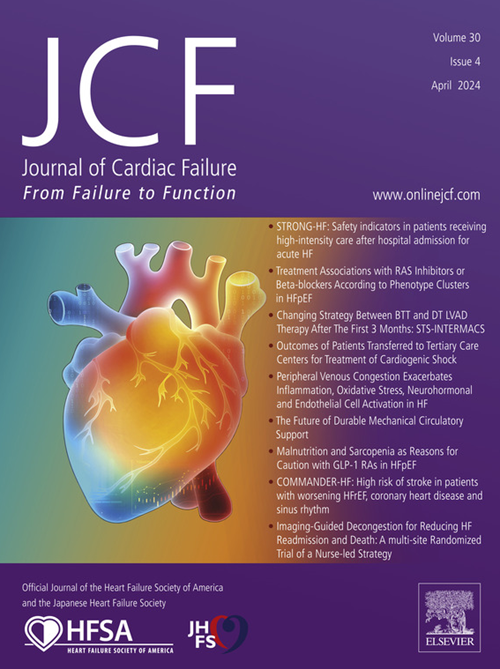堪萨斯城心肌病问卷与纽约心脏病协会分级的关系。
IF 8.2
2区 医学
Q1 CARDIAC & CARDIOVASCULAR SYSTEMS
引用次数: 0
摘要
背景:为了确定阻塞性肥厚型心肌病(oHCM)患者的候选资格和治疗反应,临床医生需要一种准确的方法来评估症状、功能和生活质量。虽然纽约心脏协会(NYHA)分类法最常用,但堪萨斯城心肌病问卷(KCCQ-23)更准确,对变化也更敏感,只是临床医生不太熟悉。为了支持对 KCCQ 的解释,我们结合 NYHA 对 KCCQ 评分的横断面和变化进行了描述:EXPLORER-HCM试验(NCT03470545)的参与者完成了KCCQ-23,临床医生在研究访问中分配了NYHA分级。如果参与者有基线数据和第 30 周的横向和纵向变化数据,则将其纳入研究。按基线和第30周时的NYHA分级以及从基线到第30周NYHA分级的变化比较KCCQ-23的中位数得分:横断面上,KCCQ-23 总简易评分(KCCQ-23 OSS)和临床简易评分(KCCQ-23 CSS)与基线和第 30 周时的 NYHA 呈反比关系,同一 NYHA 分级患者的 KCCQ-23 评分差异明显。当从 NYHA II 级改善到 I 级时,KCCQ-23 OSS 和 KCCQ-23 CSS 的中位变化分别为 10(IQR 4,22)和 8(IQR 2,20)。从 NYHA III 级升至 II 级和从 NYHA III 级升至 I 级时,变化幅度更大:结论:KCCQ-23评分与NYHA分级成反比,分级内存在显著差异。得分的变化不是线性的,表明患者在 NYHA II 级和 III 级之间的变化比 I 级和 II 级之间的变化差异更大。这些见解有助于临床医生更好地理解 KCCQ 评分的横截面和变化。本文章由计算机程序翻译,如有差异,请以英文原文为准。
The Kansas City Cardiomyopathy Questionnaire in Relation to New York Heart Association Class
Background
In order to identify candidacy and treatment response for patients with obstructive hypertrophic cardiomyopathy (oHCM), clinicians need an accurate means of assessing symptoms, function, and quality of life. While the New York Heart Association (NYHA) Classification is most often used for this purpose, the Kansas City Cardiomyopathy Questionnaire (KCCQ-23) is more accurate and sensitive to change, although less familiar to practicing clinicians. To support interpreting the KCCQ-23, we describe cross-sectional and longitudinal changes in KCCQ scores in the context of the NYHA.
Methods
Participants from the EXPLORER-HCM trial (NCT03470545) completed the KCCQ-23 and clinicians assigned NYHA classes at study visits. Participants were included if they had baseline and week 30 data for cross-sectional and longitudinal changes. Median KCCQ-23 scores were compared by NYHA class at baseline and week 30 and by change in NYHA class from baseline to week 30.
Results
Cross-sectionally, the KCCQ-23 Overall Summary Scores (KCCQ-23 OSS) and Clinical Summary Scores (KCCQ-23 CSS) had an inverse relationship with the NYHA class at baseline and 30 weeks, with marked variations in KCCQ-23 scores among patients assigned to the same NYHA class. When improving from NYHA class II to I, the median changes in KCCQ-23 OSS and KCCQ-23 CSS were 10 (IQR 4, 22) and 8 (IQR 2, 20), respectively. The changes were larger when improving from NYHA class III to II and from NYHA class III to I.
Conclusion
KCCQ-23 scores are inversely related to NYHA classes, with significant variability within classes. Changes in scores are not linear, suggesting greater differences when patients move between NYHA Classes II and III than when moving between Classes I and II. These insights may help clinicians better understand cross-sectional and longitudinal changes in KCCQ scores.
求助全文
通过发布文献求助,成功后即可免费获取论文全文。
去求助
来源期刊

Journal of Cardiac Failure
医学-心血管系统
CiteScore
7.80
自引率
8.30%
发文量
653
审稿时长
21 days
期刊介绍:
Journal of Cardiac Failure publishes original, peer-reviewed communications of scientific excellence and review articles on clinical research, basic human studies, animal studies, and bench research with potential clinical applications to heart failure - pathogenesis, etiology, epidemiology, pathophysiological mechanisms, assessment, prevention, and treatment.
 求助内容:
求助内容: 应助结果提醒方式:
应助结果提醒方式:


